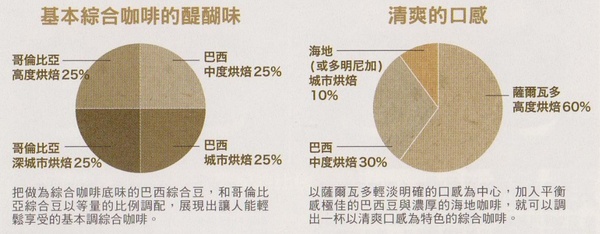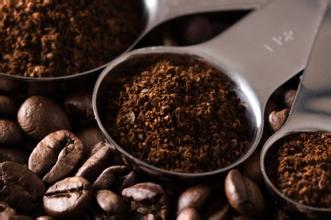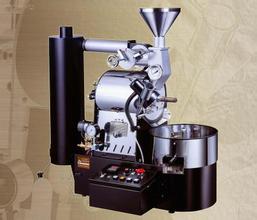Blending of single mixed coffee espresso blending proportion and flavor characteristics of coffee beans
The previous has briefly talked about the meaning of the blending of comprehensive coffee and two more popular blending concepts. Today, I would like to share with you several specific recipes for mixed coffee (as each family has its own understanding of different roasting and the quality of the raw beans used, the formula mentioned in this article may not be suitable for everyone. The numbers represent the recommended ratio).
Comprehensive coffee mix one: Brazil (4), Colombia (3), Harald (2), Kenya (1).
Introduction to coffee beans: urban roasting in Brazil and Colombia shows more profound characteristics, while highly roasted Harald still has a prominent sour taste, while Kenya uses a baking degree between urban roasting and deep urban baking. the faint aroma of red wine and low acidity show a great convergence of wild flavor.
What about the taste of the mixed coffee made with these four kinds of beans?
Cup test evaluation: the aroma is full-bodied and soft, with faint aromas of flowers and fruits. In taste, sour and sweet can be obviously felt, but not irritating, bitterness is slightly more obvious, mellow and comfortable. In particular, the aftertaste is very long and obvious (the bitterness of Brazilian coffee is well reflected).
The overall smoothness of this mixed coffee is long, rich but not exciting, and it still has a rich flavor even if it is cooled a little.

Comprehensive coffee blending II: Brazil (2), Harald (2), Kenya (1).
Introduction to coffee beans: city baked Brazil, the characteristics of bitter sweet taste is very obvious. The Harald flavor of the city baked is more calm, the sour taste is less wild and more rich and low-key, while the city-baked Kenya still retains a relatively obvious sour red wine, fruit aroma, rich and lively flavor.
What is so special about the taste of the mixed coffee made from these three coffee beans with the same roasting degree?
Cup evaluation: rich aroma, obvious floral and fruity aromas (contribution of Kenya). The bitter taste is more obvious, but the bitter taste is crisp and powerful, and then brings obvious sweetness; the sour taste has a clear red wine flavor, with a faint Harald fruit acid performance, the overall feeling is sweet and clear. The performance of Yu Yun is long, and Huigan is very obvious.
The sour taste of this comprehensive coffee is perfect, and the bittersweet characteristics of Brazilian coffee are incisively and vividly, but the only drawback is that the characteristics of Harald coffee are not so obvious against the strong strength of Kenya, but it does not have a great impact on the overall flavor performance.
Integrated coffee mix three: Brazil (2), Harald (1), Kenya (1).
Introduction to coffee beans: highly roasted Brazil has a relatively clear sour taste. The Harald flavor baked in the city is less wild and more calm. Between urban baking and deep urban baking, the Kenyan flavor is rich and steady, less active and more heavy.
How does this coffee perform?
Cup evaluation: there is an obvious floral aroma in the aroma and reveals the flavor of the fruit (Harald's contribution). The sour taste is more obvious (because the Brazilian coffee as the base uses a lighter baking degree to increase the sour taste), Harald's fruit sour taste is more obvious. The bitterness is not obvious. The overall taste gives people a deep and heavy feeling, rich but changeable, difficult to guess at once.
This coffee uses Brazil, which is highly roasted rather than city-baked, as the base, making the sour taste of the coffee much clearer, and deep-baked Kenya avoids this clear trend of sour expression toward thinness. it is unexpected that the overall flavor is thick, rich and varied.
The above three recipes all use Brazil (the first one uses Brazil and Colombia) as the base, mainly because the flavor of Brazil is the most balanced and simple, suitable for use as a stable base. Blending is an art, the proportion and baking degree mentioned in the formula are not fixed, you can try different proportions of coffee, maybe there will be a better flavor performance. So it is absolutely right to say that mixed coffee reflects a store's baking skills and understanding of coffee. I hope you can come up with a good way of blending, study together, and carry out the pursuit of fine coffee to the end.
Source: happy Coffee Xiao Xu's blog
Important Notice :
前街咖啡 FrontStreet Coffee has moved to new addredd:
FrontStreet Coffee Address: 315,Donghua East Road,GuangZhou
Tel:020 38364473
- Prev

Espresso production: the effect of grinding thickness of coffee beans on the quality of coffee
I talked about the steps of pressing powder in the process of making Espresso and the strength of pressing powder, and mentioned a little about the factors that affect the strength of pressing powder, one of which is the degree of grinding of coffee powder. Grinding refers to the process of grinding coffee beans into the coffee powder used in making coffee by using a bean grinder (or manual grinding apparatus), and the degree of grinding refers to the thickness of the coffee powder.
- Next

Types and characteristics of roaster introduction of hot-air direct-fire semi-hot-air coffee roaster
There are three common types of roaster, namely, hot air type, direct fire type, and semi-direct fire semi-hot air type. Next, I would like to introduce to you the characteristics of the three models. 1. Hot air type: a hot air roaster uses a blower to suck in air. After letting the air pass through a heating coil to raise its temperature, hot air is used as a heating source to bake coffee beans. Hot air can not only provide baking.
Related
- Beginners will see the "Coffee pull flower" guide!
- What is the difference between ice blog purified milk and ordinary milk coffee?
- Why is the Philippines the largest producer of crops in Liberia?
- For coffee extraction, should the fine powder be retained?
- How does extracted espresso fill pressed powder? How much strength does it take to press the powder?
- How to make jasmine cold extract coffee? Is the jasmine + latte good?
- Will this little toy really make the coffee taste better? How does Lily Drip affect coffee extraction?
- Will the action of slapping the filter cup also affect coffee extraction?
- What's the difference between powder-to-water ratio and powder-to-liquid ratio?
- What is the Ethiopian local species? What does it have to do with Heirloom native species?

